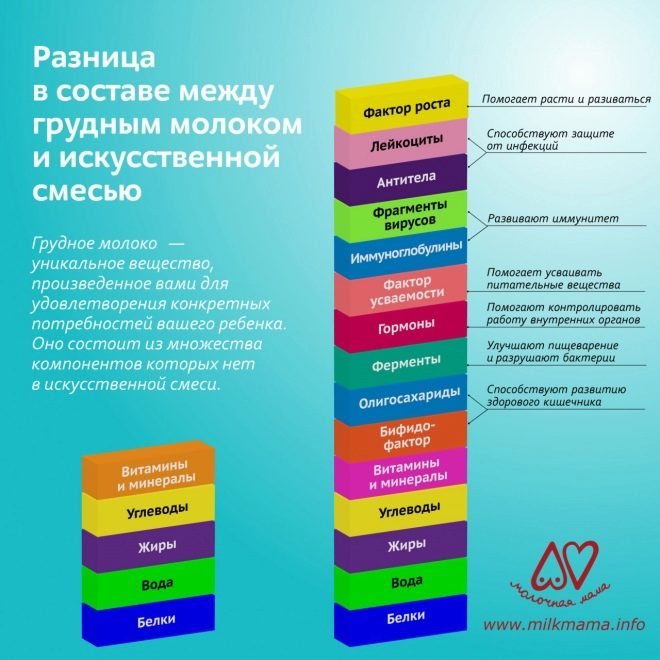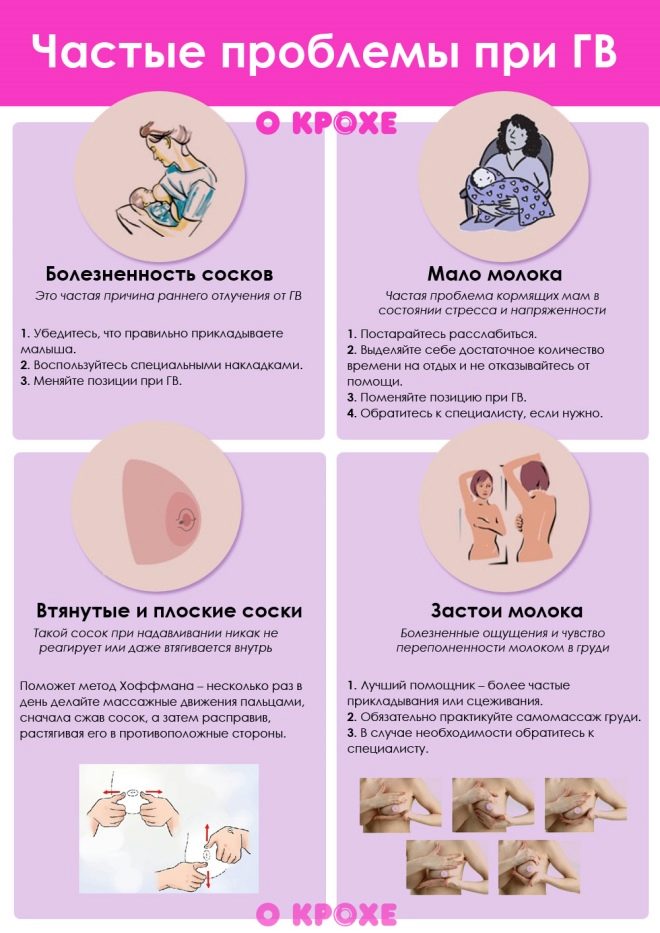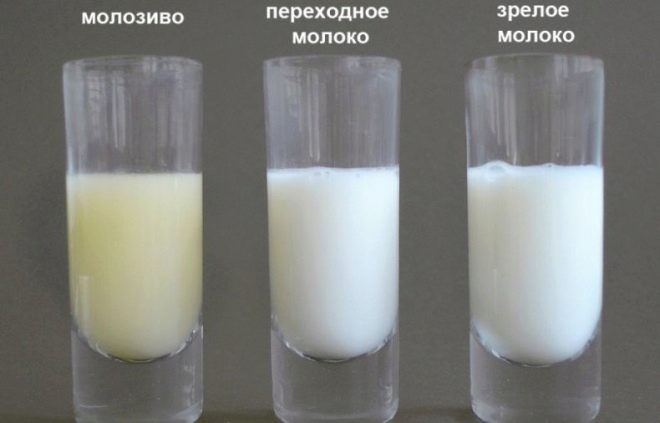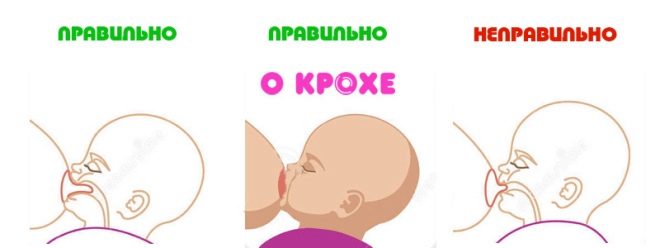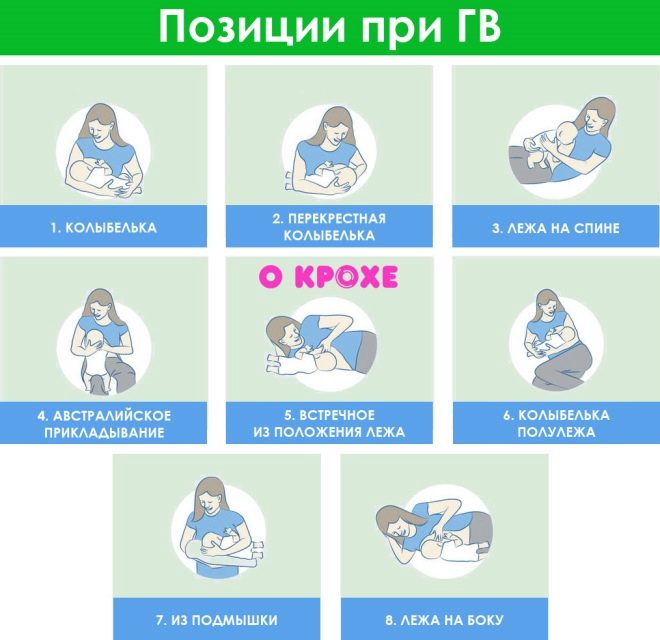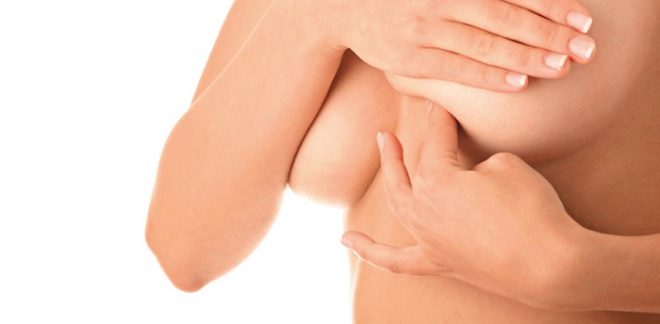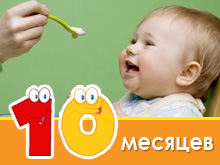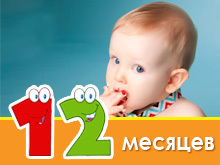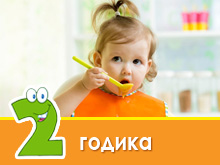Breastfeeding of newborns and infants. Features in the early days and months
Feeding with breast milk is recognized as the safest and most useful way of feeding a child in the first year of life. With all the simplicity of breastfeeding, there are quite a few misconceptions and difficulties that can prevent to adjust lactation. Let's consider a natural process such as breastfeeding (HB) that is accessible to every woman who has given birth, in more detail.
Benefit
When receiving breast milk, the infant will grow and develop harmoniously. The baby will feel good, the risk of development will decrease anemia, allergies, rickets, gastrointestinal diseases and other pathologies. In addition, the emotional contact with the mother acquired during breastfeeding will contribute to the development of the personality of the toddler in a positive way.
Why do breast milk need babies?
- Breast milk unique compositionwhich cannot be reproduced even by the best blend manufacturers.
- Female milk is nutritious food for the baby. It gives the child's body the necessary proteins, minerals, carbohydrates, vitamins, healthy fats and other valuable substances.
- Breast milk is easily digested and digested in the still immature karapuz digestive tract without problems.
- Breast milk has a constant temperature, so it is always ready to eat by the baby.
- The composition of milk changes as the baby matures, adjusting to the changing needs of the toddler.
Pluses for nursing mothers
- Sucking through nipple stimulation stimulates the production of oxytocin. This hormone is responsible for reducing the muscles of the uterus, so breastfeeding contributes to a more rapid recovery of the uterus in the postpartum period.
- Breastfeeding a baby lowers the risk of malignant tumors of the ovaries and breasts in women.
- Depressed women are more rare in lactating women, and their resistance to stress is much higher than among mothers who do not breastfeed their babies after delivery.
- Breastfeeding can save the family budget, since milk substitutes are quite expensive.
Statistics show that mothers and their babies need breastfeeding. Watch the following video about the benefits of breastfeeding a baby.
What are the cons?
- Mom's body loses microelements and vitamins, so it is important to fill them proper and complete nutrition of a nursing motherand, if necessary, multivitamin preparations. If the mother’s diet is poor, the risk of damage to the woman’s teeth and hair, as well as pain in the joints, increases.
- HB may affect a woman's well-being. A nursing mother may develop drowsiness, decrease libido, decrease concentration of attention and memory, may pull on sweet things, and often suffer from thirst.
- The chest loses its former elasticity and shape, and may also decrease in size. This is primarily due to the production of hormones in the body of a pregnant woman and after childbirth.Even if a woman refuses breastfeeding, this does not guarantee the preservation of her bust. At the same time, if a nursing mother constantly declines, incorrectly applies the child, bandages the breast at the end of lactation, or loses weight sharply after weaning, this directly affects the appearance of the breast. Separating the baby gradually, many manage to regain the pre-pregnant breast shape.
- Sometimes one breast after lactation looks different than the second. This can be prevented by alternately applying to each breast.
- Stuffed breasts and altered nipple sensitivity may affect the intimate life of the mother during the postpartum period, but such discomfort is temporary.
- Breastfeeding often brings a young mother inconvenience. Women who are accustomed to an active lifestyle, it is difficult to rebuild life, taking into account the HB, which actually binds it to the baby. The child has to be fed at night, sometimes you need to express milk, you can’t leave a crumb for other people for a long time, you have to limit your diet, refuse coffee, alcohol, smoking, sleep on your stomach.
A nursing mother has many unnecessary experiences, especially in relation to the quantity and quality of breast milk. In addition, relatives who do not support breastfeeding often psychologically influence a young mother. It is very important positive attitude to feeding and the ability to defend their opinions.
Are there any contraindications for HB?
A baby cannot be breastfed if:
- Mother has dangerous diseases - HIV, acute psychosis, acute infections, open tuberculosis, oncopathology.
- Mom uses alcohol or drugs.
- Mom is forced to take drugs that are prohibited in HB.
- The baby can not suck the breast, for example, with deep prematurity or serious illness.
- The baby has some congenital diseases associated with the absorption of breast milk, for example, galactosemia.
Bad habits and their effects on milk
Nursing mothers should not smoke, because under the influence of nicotine worsens the production of prolactin. If mother smokes, milk is produced in smaller quantities, and its quality suffers. Nicotine entering the children's body negatively affects the rhythm of the baby's heartbeat, sleep and the appetite of the baby, as well as the nervous system of the baby.
If the baby becomes a passive smoker, it threatens him with problems with the vessels, respiratory system, and also allergies. Especially dangerous is the fact that, due to mom's smoking, the crumbs increase the risk of sudden death.
If a smoking woman cannot give up cigarettes, you should try to reduce their number - up to a maximum of 5 per day. Smoking before feeding is unacceptable, because a large number of harmful compounds will be released into the milk. Having smoked a cigarette after feeding, by the next feeding, nicotine will partially disappear from mom's body. In this case, the mother should not smoke next to the child, and after smoking you need to wash your hands well, brush your teeth and change clothes.
Alcohol consumption, as well as drugs, is unacceptable for a nursing mother. Alcoholic beverages in any quantity are harmful to a breastfed infant. They affect the nervous system and heart of the toddler, as well as the digestive system of the baby. It is especially important not to consume any alcoholic beverages up to 3 months of age of the child, since the liver of the newborn is unable to process even the minimum dose of ethyl alcohol.
Little about colostrum
Colostrum called the fluid released from the female breast during the first three to four days of the postpartum period. Its number is small (especially immediately after childbirth), the color is yellowish, and the consistency is thick.
Differences of such a secret of the mammary glands from mature breast milk are higher content of protein, mineral salts and vitamins, as well as the presence of a significant number of white blood cells, immunoglobulins and other protective factors.Lactose and fat, by contrast, is less in colostrum.
Why is colostrum so important for baby and how it appears, look in the video of the channel “School of Moms and Dads”, where an experienced obstetrician-gynecologist talks about the many nuances of the appearance of colostrum and breast milk.
Feed the baby on demand or establish a regime?
It is recommended to give babies breasts at every request for babies. In relation to the newborn, this means that any anxiety should first be offered to the breast, and if the crumb refuses, then look for another reason for the infant's agitation.
In the first weeks, babies literally “hang” on the chest, but over time, the crumbs form their own specific feeding regime. A newborn can be applied to the mother's breast for up to four times in one hour, from 12 to 20 times during the day. Basically, the child sucks while falling asleep, as well as upon waking. If any discomfort appears, the crumb will ask the breast more often and suck it longer. Long sucking and frequent application are typical for babies after hard childbirth.
Up to 2 months, babies are applied in the daytime on average every 1-1.5 hours, and older than 2 months - every 1.5-2 hours. In babies of 4-6 months of age, the frequency of attachments decreases, but the approximate number of feedings is 12 per day.
Be sure to feed the baby at night, because it is in the dark (from 3 to 8 am) that the production of prolactin is stimulated, and this hormone is extremely important for lactation. Feeding at night is required for the baby during all breastfeeding, therefore, at the end of breastfeeding, the abandonment of night sucking should be the last stage of weaning.
Breastfeeding is a reciprocal process, so the requirements for feeding may be on the part of the mother. Usually, a woman needs to feed her baby every 1.5-2 hours, which corresponds to the needs of the baby. If the baby has not been attached for a long time, the mother should offer the breast to the baby. This is especially important for babies younger than 3 months, as well as premature babies, sick babies and children with underweight body weight.
Can I feed my baby out?
Breastfeeding is especially convenient because you can feed your baby on the trip without any problems. Mom does not need to carry with her water, bottles, mixture, heater and other items, without which it will not be possible to prepare the baby artificial food. If you decide to give a bottle of expressed milk or a mixture out of the house, you can affect lactation, as the baby will receive food from the nipple with less effort.
In most cases, feeding babies in public places is treated with understanding. Especially nowadays there are special clothes in which a nursing mother can give a baby's breast imperceptibly to others. In such clothes, only that part of the breast that the baby captures is exposed. Buying such clothes allows a nursing mother to go with an infant to an exhibition, to a store, to a park, and even to a business meeting.
Possible problems
Lack of milk
The actual lack of production of breast milk is only 3% of nursing mothers. The rest of the women, who believe that they have little milk, this condition is associated with easily removable factors. The causes of hypolactation are stresses, improper attachment of the crumbs, poor nutrition of a woman, improperly organized feeding regime, and other reasons.
Making sure that the baby doesn’t have enough milk will help in weighing and counting wet diapers. Weigh the crumbs should be once a month. It is also permissible to weigh once every 2 weeks or every week, but it is impractical to measure the child’s weight more often (daily weighings are not objective). A healthy baby with enough nutrition gains at least 120 grams per week.
Counting urination is considered a more informative test than weighing.If the baby has enough breast milk per day, the mother will count 10–20 wet diapers. Read more in the article Is Baby Breast Enough?.
Achieve increase milk production helps more frequent attachment, feeding the child at night, changing the drinking regime, good nutrition, shower and bath for the chest, as well as the use of special tea. It is very important that the woman be configured to breastfeed, know the proper feeding technique, promptly contact the counselors and be supported by family and other mothers with breastfeeding experience for at least a year.
Hyperlactation
Excessive production of milk in the breast causes great discomfort for a woman. She feels that her breasts are bursting, the mammary glands are becoming painful, the milk is leaking. In addition, during hyperlactation in mom, the child gets too much liquid milk, which is called "front", and, accordingly, loses more fatty milk remaining in the posterior glands. This leads to digestive disorders of the baby.
The most common reason for too active milk production in women is intense and prolonged pumping after feeding. Also, excess lactation and lactogonic agents can lead to hyper lactation. It happens that hyperlactation is an individual feature of the body of a nursing mother, and then to cope with it is not easy. It is necessary to limit drinking and control the diet so that it does not provoke products that produce excessive milk.
When pumping, it is necessary to take a responsible approach to the procedure, since it affects the health of the breast. ABOUT types of pumping and breast pumping technique read in other articles.
In addition, we offer on this topic to watch the video.
Baby refuses breast
The cause of failure may be stuffy nose, ear inflammation, stomatitis, teething, colic, and other health problems of the baby. Changing mom's diet, such as eating spicy foods or spices, can affect the taste of milk, so the crumb will refuse to suck breast. The use of pacifiers and feeding a baby from a bottle often leads to failure.
The situation is quite common when an older toddler at 3-6 months of age can refuse to feed, as its demand for milk decreases, and the pauses between feedings are lengthened. During this period, the infant studies the world around with interest and is often distracted from sucking. At the age of 8-9 months, the rejection of the breast can be triggered by the very active introduction of complementary foods.
Establishing contact between the baby and the mother will help solve the problem of breast failure. The crumb needs to be worn more often on his arms, hugging, talking to the baby. It is necessary to give supplements, medicines or drinking only from a spoon or from a cup, it is advisable to give up empty pads, and the mother’s menu should not include products that are unpleasant to the infant.
Chokes
The baby may choke on too “greedy” sucking, but also this situation may indicate excessively rapid flow of milk from the female breast. If the newborn began to choke while feeding, it is worth changing the position in which the baby eats. It is best to sit up straight and keep the baby's head higher.
In the case when the cause of choking is an excess of milk, you can slightly strain the breast before offering the baby. If a change of posture and preezing did not help, contact a specialist, as the causes may be different pathologies of the oral cavity, larynx, or the functioning of the nervous system.
On the most common problems and how to solve them, see the video, in which experienced obstetrician-gynecologists tell important nuances.
Do I need to wash my breasts before feeding?
Nursing mothers should not fanatically follow the rules of hygiene and wash the breasts before each feeding, especially when using soap. It is able to destroy the natural protective film covering the skin of the areola. As a result, frequent washing with soap causes cracks, which will make feeding the baby very painful.
In addition, detergents have the ability to interrupt the natural flavor of the skin, even if the soap does not have a perfume fragrance. It is very important for the newborn to catch the smell of his mother during the feeding, therefore, without feeling him, the pussy will start to worry and may even refuse to suck milk. To maintain cleanliness, it is enough to wash women's breasts once or twice a day, while only warm water should be used for washing.
Proper breast care for a nursing mother is an important point to avoid many problems. See the video for more details.
How to put the baby to the chest?
When organizing hepatitis B, it is especially important that the capture of the tiny breast should be correct, since breach of the grip of the chest can lead to excessive air ingestion and insufficient weight gain. In the baby’s mouth there should be not only the nipple, but also part of the area of the mammary gland around the nipple, which is called the areola. In this case, the lips of the baby should be slightly twisted. In this case the toddler will be able to suck properly.
Mom should have no pain during sucking, and feeding can last for a long time. If the attachment of the baby is not correct, the woman will have pain during feeding, the nipples may be damaged, the baby will not be able to suck out the volume of milk he needs and will not eat enough.
Experiment and look for the type of breast attachment that will be most comfortable for you and your baby. If the nipple is damaged, you can use a softening cream like "Bepanten".
How to properly attach the baby to the chest, read in another article or see in the video.
How to understand that the child is fed up?
The duration of each feeding is individual and may vary from one child to another and from one baby in different situations. Most kids have 15-20 minutes to empty their breasts and eat, but there are tots that suck at least 30 minutes. If you interrupt the feeding of such a child earlier, he will be undernourished. Mom will understand that the baby-eater ate when the baby stopped sucking and released the breast. Take away the chest before this point is not worth it.
Debunk Myths
Myth 1. Before birth, nipples should be trained.
Women are recommended to rub their nipples with a coarse cloth, but such actions are more dangerous than helpful. Stimulation of the nipples of a pregnant woman increases the risk of premature birth, since there is a definite connection between the breast and the uterus (if the nipple is stimulated, the uterus will contract).
Myth 2. A newborn should be immediately fed with a mixture, since milk does not come immediately
Mature milk, in fact, begins to dwell from the 3-5th day after delivery, but until that moment colostrum is released from the breast of a woman, which is enough for the baby.
Myth 3. For a successful HB, you constantly have to decant after each feeding of the baby.
Decantations after feedings are recommended by close relatives and even sometimes by doctors, ostensibly for the prevention of lactostasis, but in fact they are the ones that cause excessive milk production and stagnation. To strain the chest is only with pain and a strong presence, when the crumbs can not capture the nipple. In this case, you need to express a small amount of milk.
Myth 4. If a child cries a lot and often requires a breast, then he is hungry and does not eat enough
Compared to feeding with a mixture, the baby actually asks the breast more often, since breast milk is absorbed very quickly, and the mixture - longer. In addition, it is often easier to suck milk from a bottle of crumbs than to get it from the breast.But this behavior does not indicate a shortage of food for the toddler. You should focus only on the weight gain per month and the number of urinations of the baby per day.
Myth 5. Different women have different milk fat content.
Some women are lucky and they have fat milk, and others are not lucky, because they have low-fat blue milk. Such a misconception is related to the color of the expressed milk, the front portion of which really has a bluish tint. This part of the milk is a drink for the crumbs, so it is impossible to judge by its color what kind of milk is in a woman as a whole. If mom had managed to decant milk from the back sections of the breast, she would be sure of its fat content, but it is very difficult to manually obtain it.
Myth 6. Breast stopped filling up, which means that the baby lacks milk.
This situation often occurs after a month or two of feeding, when the woman begins to feel that the milk no longer arrives in the right amount. Experiences worsen the situation even more and may lead to the completion of lactation. In fact, the absence of hot flashes is in no way connected with the amount of milk in the female breast, since 1-2 months after delivery the milk begins to produce as much as it needs for the crumbs, and it comes to the gland often in the process of sucking the baby's mother's breast.
Myth 7. A nursing mother needs to eat more than usual.
Undoubtedly, the nutrition of the mommy, who is breastfeeding the baby, must be of high quality and balanced. However, for this you should not significantly increase the portions. The baby will get all the nutrients from breast milk, even if the mother will eat very poorly, but at the same time the woman’s health will be undermined by a lack of vitamins. So nutrition should be given close attention, but not the volume of dishes, but their usefulness. It should also be remembered that, up to 9 months of age, nursing mothers should not sit on diets and train hard.
Myth 8. The mixture is almost identical to breast milk, so it doesn’t matter what to feed the baby.
No matter how the manufacturers praise their high-quality mixtures and whatever valuable ingredients they add to them, no artificial nutrition can match the milk from the female breast. An important difference between these two food options for an infant is that the composition of breast milk changes in accordance with the growth of the baby and the needs of the baby. Let's not forget about the psychological connection between a nursing mother and a baby.
Myth 9. After 6 months milk is no longer needed
Although the six-month-old toddler is already beginning to introduce complementary foods, breast milk still remains the staple food of the infant. It does not lose its valuable properties and when the child is one or two years old.
Myth 10
If there are cracks from sucking, it is better to go to the mixture. The situation when the baby in the early days of sucking rubs the nipples to the blood, quite frequent. The reason for it is incorrect attachment. And having corrected it, it is quite possible to breastfeed the baby for a long time. Also, the rapid healing of cracks contributes to the use of special linings.
When should stop GW?
According to experts, the best time to stop breastfeeding is the period of involution. Most often, this stage of lactation occurs at the age of a child from 1.5 to 2.5 years. To complete GW, it is important to take into account the readiness of both the child and mother. The gradual collapse of lactation will not damage either the mental state of the baby, or her mother's breast.
There are situations when it is necessary to stop GW sharply, for example, in acute illness of the mother. In this case, you should be guided by the doctor's advice, so that the process of parting the little ones with the breast, and of the mammary glands with milk, is the least painful for everyone.
Read more about cessation of lactation read in another article.
Important Tips
- To successfully establish lactation, it is important to take care of the early attachment of the baby to her mother's breast. Ideally, the infant should be placed on the woman’s abdomen and find the breast immediately after delivery. Such a contact will trigger the natural mechanisms of lactation regulation.
- While waiting for the arrival of mature milk, you should not feed the infant with the mixture. Because of the small amount of colostrum, many women are experiencing, believing that the crumb goes hungry. However, in colostrum there are valuable substances for babies, and supplementation with the mixture can greatly harm the formation of lactation.
- Do not replace mother's breasts with a dummy. Let the baby get the breast whenever he wants to suck. The use of nipples will help to divert the toddler, but can adversely affect lactation, especially if it has not yet been established. In addition, the breast for the newborn is not only a source of food. During sucking between the baby and the mother a deep psychological contact is established.
- If you give a breast to a baby on demand, you do not need to feed the crumbs with water. The first part of the sucked milk is represented by a more liquid part containing a lot of water, therefore it serves as a drink for the infant. If you give water to the baby additionally, it can reduce the amount of lactation.
- It is not necessary to cesspit after feeding until complete devastation. This advice was distributed at a time when all the children were advised to feed by the hour. Babies were rarely attached to the breast, and because of the lack of stimulation, milk was produced less, so they had to additionally provoke milk production by full pumping. Now breast offer crumbs on demand and during sucking the baby gives a request for the next feeding - how much baby sucks milk, so much and develop it. If you further express the breast when the crumb has already been fed, the next time the milk will arrive more than the toddler needs. This increases the risk of lactostasis.
- It is not necessary to give the child a second breast until the infant draws the first breast. In the first months it is recommended to alternate the chest no more often than every 1-2 hours. If you give the baby a second breast, when he has not yet sucked the back milk from the first, it threatens digestive problems. Of both breasts, it may be necessary to feed a child older than 5 months of age.
- No need to rush start feeding in the children's diet. Infants exclusively on breastfeeding receive enough nutrients up to 6 months of age. And even after half a year, the milk remains the main food for the infant, and with the help of all the new products, the crumb first simply recognizes the tastes and texture that are different from that of the milk.
- Find out what feeding poses are. since a change of posture during the day will help prevent milk stagnation, because in different positions the baby will suck more actively from different lobes of the breast. The main postures that every nursing mom should master are feeding lying down and feeding in a sitting position from under the armpit.
- Doctors call the minimum term of breastfeeding 1 year, and experts believe that the optimal duration of feeding for women's milk is 2-3 years. Earlier weaning can go through with difficulties both for the psyche of the infant and for the breast of the woman.
- It is not necessary to refuse breastfeeding for any illness of the mother. For example, if a woman has ARVI, you should not interrupt feeding, since the crumb will get antibodies from her mother’s milk. Lactation can prevent only those diseases that we have indicated in contraindications.
WHO recommendations
For successful breastfeeding, the World Health Organization recommends:
- Attach the child for the first time to her mother's breast in the first hour after birth.
- Giving baby chests at the request of the baby.
- Feed the baby at night.
- Adhere to exclusive breastfeeding up to 6 months of age.
- Do not feed the child with water before the introduction of complementary foods.
- Starting to introduce additional food, continue HB to at least 1 year of age.
- Do not use means that imitate the female breast (soother, bottle with nipple) during HB.
- Do not express breast unnecessarily.
What does Dr. Komarovsky think about breastfeeding?look in his transfer.


